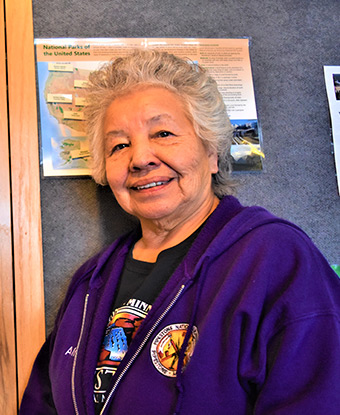Last updated: August 31, 2020
Person
Alice Derby-Erickson

NPS/Anne Dowd
Alice Derby-Erickson was born and raised in Pipestone and is the granddaughter of Moses and Estelle Crow. Her parents, Harvey and Ethel Derby, were heavily involved with Pipestone National Monument throughout the mid-1900s. Harvey and Ethel spent a lot of time at the pipestone quarries, talking to visitors and mining the stone, and they often included their children in the process. Alice and all six of her siblings (as well as their collective 21 children) became pipestone artists, either carving pipes, making trinkets, or doing decorative beadwork. Alice made pipes in her younger years, but specialized in small pipestone crafts, particularly those featuring turtles. She remembers her introduction to the craft as a young girl:
“My mother taught me to carve turtles when I was 9 or 10. I [helped] the family sand some of their pieces too. . . . I used to help with some quarrying, hauling dirt and building the rock wall. We would quarry by the seasons usually to avoid the water. We were always taught that we need to be happy when we come here otherwise the work will be hard.”
Alice was given her tribal name, Dancing Flower, by her grandmother, Estelle Crow. Alice was only 10 or 11 years old at the time, but already her grandmother could see her love for dancing in the pow wows, and she recognized Alice’s penchant for picking wildflowers. Alice grew up respecting her grandmother and the morals she upheld, and even today, wishes to follow in her footsteps. “Women are so much the backbone of the family. Without us, not a lot would get done.”
Alice has always been closely connected to Pipestone National Monument through her family ties, but in 1975 she became a park ranger with the National Park Service. For the next 30 years, she helped visitors discover the site and learn about the heritage of this area. “I wanted to have a part in this park. The ranger role fit well because of the interpretive aspect. I want people to know the importance of this place when they visit.” Alice remembers working closely with another female park ranger, Betty McSwain, who also worked at the monument for 30 years. The two women strongly influenced one another, and played important roles in teaching others about the significance of this special place.
Alice retired from the National Park Service in 2005. Since 2015 she has served as a sales clerk and cultural demonstrator for the Pipestone Indian Shrine Association. Today, you can visit Alice in the gift shop, and purchase her signature turtle effigies and feather motif jewelry. She is a respected third-generation pipestone artist, and her son, Travis Erickson, is one of the most well-known pipestone carvers active today. When asked what Alice would like to see for the future of the monument, she responded “I would like to see it stay as it is, without any changes.”
